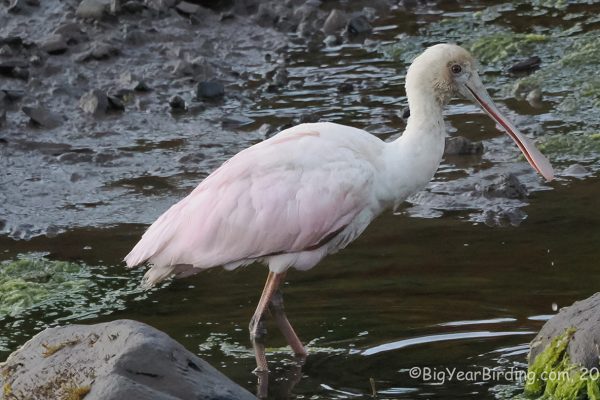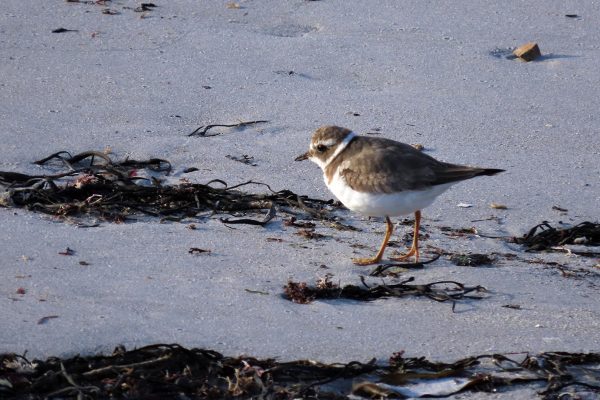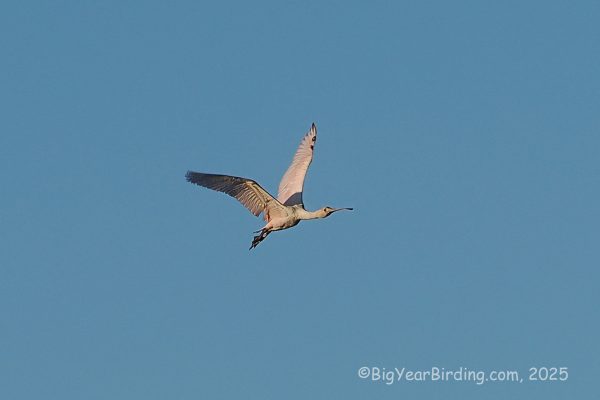Who would have guessed that Downeast Maine would be where the Canadian Arctic and South Florida come together (sort of)? If you’re a birder, you may already know what we’re talking about.
That’s right, two birds from two seemingly different worlds.

Roseate Spoonbills are found in south Florida and other parts south. One has shown up in Downeast Maine. (Photo courtesy of Ethan Whitaker)
A little over a week ago, a visitor from Florida was in the small coastal town of Cutler, in Washington County, Maine, only 20 miles from the Canadian border. There they were enjoying the sights and sounds of quintessential Maine birds—Common Eiders, Herring Gulls, Black Guillemots when they spotted something pink.
Maine is not known for its pink birds.
Yet there it was, a pink wading bird with a bill shaped like a spoon—a Roseate Spoonbill. That’s a bird that, in the U.S., nests only in South Florida and along the Gulf Coast of Texas to western Louisiana, more than 1,200 miles away from coastal Maine. It’s a bird that people travel from all across the U.S. and Canada to south Florida (or coastal Texas/Louisiana) in order to catch a glimpse of.
The good news, if you haven’t been to see the spoonbill yet, is that the bird is still there as we write. Amazingly (or maybe ironically), there have been at least two eBird checklists that have reported seeing both the Roseate Spoonbill and Canada Jay at the same time and place in Cutler. If you are not familiar with the Canada Jay, it’s a bird that reaches the southeastern limit of its extensive northern breeding range in states bordering Canada. Many birders come to Maine to see them because they aren’t typically found farther south. It would be exceedingly rare to ever see both species at the same time, but it has now happened here in Downeast Maine!

Common Ringed Plovers are found in Arctic Canada – more than 1,200 miles from Maine, but one has made an appearance in Downeast Maine this summer. (Photo courtesy of Tom Aversa)
That’s the connection between Maine and south Florida. So what the one between Maine and Baffin Island?
A few days ago, a skilled birder heard the distinctive calls of a bird called the Common Ringed Plover in Addison, Maine—also in coastal Washington County. The call came from a flock of shorebirds that was startled into flight by an immature Peregrine Falcon honing its hunting skill by swooping down on them as they fed in a coastal estuary.
The Common Ringed Plover is the closely related look-alike of the familiar Semipalmated Plover that we see regularly in migration here in Maine. The Semipalmated Plover breeds in Arctic and sub-Arctic Canada and Alaska. The Common Ringed Plover, on the other hand, nests across northern Europe and Asia. But a few nest in North America–on Baffin Island, Nunavut, Canada. Just like the Roseate Spoonbill, that’s about 1,200 miles from coastal Maine, just in the opposite direction.

Maine’s rare Roseate Spoonbill in flight. (Photo courtesy of Ethan Whitaker)
Baffin Island is squarely in the Canadian Arctic. It’s more than 900 miles long—the distance from Maine to North Carolina—and Iqaluit, the capital of the territory of Nunavut, is located on the south end of the island. It’s the world’s fifth largest island, five times the size of Maine, so there’s lots of territory there and not a lot of people putting bird sightings into eBird. But it is clear that Common Ringed Plovers nest there, though how many do so is unknown. Also unknown is how many of them migrate back across Europe and south to Africa for the winter and how many may instead go south on this side of the Atlantic. A few are detected in southern Canada and the U.S. and even into the Caribbean, but they are not easy to tell apart from the more abundant and expected Semipalmated Plover.
Incredibly, Downeast Maine is playing host at the same time to both this Baffin Island bird and the south Florida native Roseate Spoonbill. How incredible to imagine Downeast Maine as the place where south Florida and Arctic Canada come together! All thanks to a couple of rare birds.
—Jeff and Allison Wells











Thank you.